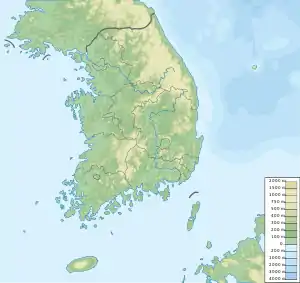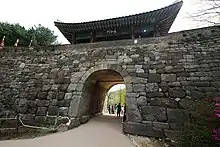| UNESCO World Heritage Site | |
|---|---|
 Sueojangdae (command post; 2002) | |
| Location | Gyeonggi Province, South Korea |
| Criteria | Cultural: (ii), (iv) |
| Reference | 1439 |
| Inscription | 2014 (38th Session) |
| Area | 409.06 ha (1.5794 sq mi) |
| Buffer zone | 853.71 ha (3.2962 sq mi) |
| Coordinates | 37°28′44″N 127°10′52″E / 37.47889°N 127.18111°E |
 Location of Namhansanseong in South Korea | |
| Namhansanseong | |
| Hangul | |
|---|---|
| Hanja | |
| Revised Romanization | Namhansanseong |
| McCune–Reischauer | Namhansansŏng |
Namhansanseong (Korean: 남한산성) is a historical mountain fortress city 25 km southeast of Seoul, South Korea. It sits approximately 480 m above sea level and is aligned with the ridges of the mountain for maximum defensibility. The fortress, stretching 12 km in length, protects a vast area used as an emergency capital city during the Joseon Dynasty of Korea (1392–1910). The design is based on fortress architecture of East Asia, embodying aspects of four historical cultural styles: the Joseon of Korea, the Azuchi-Momoyama Period of Japan, and Ming and Qing China.[1][2]
It was extensively developed during the 16th to 18th centuries, a period of continuous warfare. The technical development of weaponry and armaments during this period, which saw the use of gunpowder imported from Europe, also greatly influenced the architecture and layout of the fortress. Namhansanseong portrays how the various theories of defense mechanisms in Korea were put to form by combining the everyday living environment with defense objectives. The fortress indicates how Buddhism played an influential role in protecting the state, and it became a symbol of sovereignty in Korea.[1][2]
It stands on the Namhansan (South Han Mountain), containing fortifications that date back to the 17th century and a number of temples. It can be accessed from Seoul through Namhansanseong station of Seoul Subway Line 8.
History
.jpg.webp)
The most obvious characteristic of Namhansanseong lies in its topographical advantage; there is a spacious, flat top called Gorobong, with a low center and high sides over 480 m above sea level, as well as being a high mountain over flat lands for easy observation of the surrounding area. Due to these traits, Namhansanseong had served as a command post since the Unified Silla era in the 7th century. Unified Silla constructed the Jujangseong fortress where Namhansanseong sits today to house men and to stock supplies when it was fighting the Tang dynasty in the 7th century. In the 13th century, during the Goryeo dynasty, Namhansanseong was a stronghold against the Mongol Invasion. Since the 17th century, Namhansanseong, near the capital city of Seoul, grew greatly in size as a mountain fortress, serving as an emergency capital for the King of Joseon.
Furthermore, Namhansanseong had been systematically managed and operated for over 300 years since its construction in 1624. Specifically, it was a battlefield during the Qing invasion to acquire hegemony in East Asia during the Ming-Qing transition in China. It was the spiritual symbol of the Joseon dynasty for sovereignty, as well as a place for military security until the 20th century. The rich history of Namhansanseong shows the exchange of Buddhist, Confucian, folk religion and Christian values from the time the fortress was constructed to the present day.
.jpg.webp)
The 17th century mountain fortress Namhansanseong was constructed as a planned city both to serve as an emergency capital city during war and an administrative center in peace. Traditional villages were typically located on flat lands adjacent to mountain fortresses built for shelter in emergencies. Namhansanseong was a self-sufficient defensive fortress where the local administrative town was placed within the fortress together with the Emergency Palace. Thus, it performed various functions such as defense, administration, business and royal ancestral rites. Unlike those seen in Europe and Japan that were intended to defend only the ruling class, Namhansanseong was a defensive structure within which both the ruling class and commoners alike could shelter.
Since the 17th century, Namhansanseong has been inhabited by over 4,000 people and has been managed and preserved by the residents for generations. Most fortress towns in Korea underwent severe deformation and change during Japanese colonial times and the period of industrialization and urbanization, resulting in losing their original layout and forms. However, Namhansanseong retained its original layout because the Japanese colonial government relocated the administrative functions and demolished its military functions in the earlier stage of colonization, leaving it as an isolated mountain village thereafter.

The characteristics of Namhansanseong have changed a lot throughout its history. It served as a military and administrative center with the Emergency Palace and administrative offices from 1627 to 1917. It was the center of the civil resistance movement (Uibyeong) centering on Buddhist monk soldier temples (Seungyeong) when the Joseon Dynasty fell and the Japanese colonial period was approaching in the early 20th century. However, the fortress was demolished and the temples were forced into closure by the Japanese in 1907. The fortress lost its function as the town center due to the relocation of the Gwangju County Office in 1917, resulting in a downgrade to a remote mountain village. Then, the fortress suffered population loss and material loss during the Korean War. Nowadays, Namhansanseong is a tourist attraction, after undergoing large-scale wall restorations and being designated as a provincial park since the 1970s. It has seen a dramatic increase in the number of restaurants and various visitor facilities since the 1980s. The Emergency Palace and the Royal Ancestral Shrine within the fortress have been actively restored based on various studies on Namhansanseong since the 1990s, and it was listed on the World Heritage tentative list in 2010. It was inscribed on the UNESCO World Heritage list in 2014.The UNESCO World Heritage Committee said, "Namhan-san fortress is the only acid city built as a temporary capital in case of emergency to protect Joseon's sovereignty and independence."[2]
Conservation management
The Namhansanseong World Heritage Centre is responsible for managing and monitoring the cultural heritage of Namhansanseong, while the Namhansanseong Provincial Park Office is responsible for managing and monitoring visitor facilities within Namhansanseong and the provincial park area, in accordance with the 2012 Basic Plan on Comprehensive Improvement of Namhansanseong.[2]
Protection and management requirements
Namhansanseong is protected under the Cultural Heritage Protection Act (CHP Act) and the Natural Park Act on the national level. There are also specific ordinances and regulations at the province and city levels. On the basis of the CHP Act, the entire property is designated as a historic site and has a buffer zone surrounding the area with limitations and regulations on development and construction. The entire heritage and buffer zone is also protected as a Provincial Park covering a wider area. Under these frameworks, a Conservation Management Plan has been established to ensure the long-term protection of the fortress and the town within. A special independent entity called the Namhansanseong World Heritage Centre is responsible for the overall management of its heritage in cooperation with the Namhansanseong Provincial Park Office, the residents, local governments, experts and the central government.
Financial support comes from the national and provincial governments, and the projects are managed and operated by the Namhansanseong World Heritage Centre. A monitoring system controls the appropriate use and execution of financial resources and proposed plans.
The current status of conservation can be evaluated in three components called the military component, the governing component, and the folk component. The military component includes the fortress walls and structures, outer walls, Chimgwaejeong Arsenal, and Buddhist temples. The governing component comprises Jwajeon Shrine, Usil Shrine site, the Emergency Palace, Jwaseungdang Hall and the site of Inhwagwan Guest house. The folk component includes steles, pavilions, and intangible heritage such as rituals and rites. All these subcomponents are recorded and are managed appropriately for the form and type of heritage.
Threats to preservation of the site include developmental pressures, environmental pressures, natural disasters, risk preparedness, visitor pressure and land use. Development pressures are relatively low for Namhansanseong as the property area and buffer zones are effectively controlled by the CHP Act, the Natural Park Act and urban management planning. Visitor pressure is perhaps the highest risk factor in Namhansanseong. For the sustainable conservation of the fortress areas, preventive measures include studies on carrying capacity, regular estimation of expected visitors, and utilizing planning mechanisms with legal instruments.[2]
Gallery
 South gate of the fortress (2010)
South gate of the fortress (2010) Gate no. 10 (2010)
Gate no. 10 (2010).jpg.webp) Emergency Palace (2014)
Emergency Palace (2014)
In media and literature
- The novel Namhansanseong by Kim Hoon is based on the Second Manchu invasion of Korea in 1636, where King Injo of Joseon took refuge in the fortress.[3]
- The 2009 musical Namhansanseong, based on the novel of the same name, focuses on the lives of common people and their spirit of survival during harsh situations. It starred Yesung of boy band Super Junior as villain Jung Myung-soo, a servant-turned-interpreter. It was performed from 9 October to 14 November at Seongnam Arts Center Opera House.[4]
- Dae Jang Geum (2003)
- Dong Yi (TV series) (2010)
- The Slave Hunters (2010)
- Nobody's Daughter Haewon (2013)
- The Fortress, a 2017 film directed by Hwang Dong-hyuk, the Korean title of which is the name of this fortress itself (Namhansanseong).
- My Dearest (TV series 2023 - early episodes)
See also
References
- 1 2 "UNESCO NEWS, Namhansanseong". Retrieved 8 May 2015.
- 1 2 3 4 5 "UNESCO, Namhansanseong". Retrieved 8 May 2015.
- ↑ Koh Young-aah "Musicals hope for seasonal bounce" Korea Herald. 30 March 2010. Retrieved 2012-03-30
- ↑ "2 Super Junior members cast for musical" Asiae. 15 September 2009. Retrieved 2012-04-17

